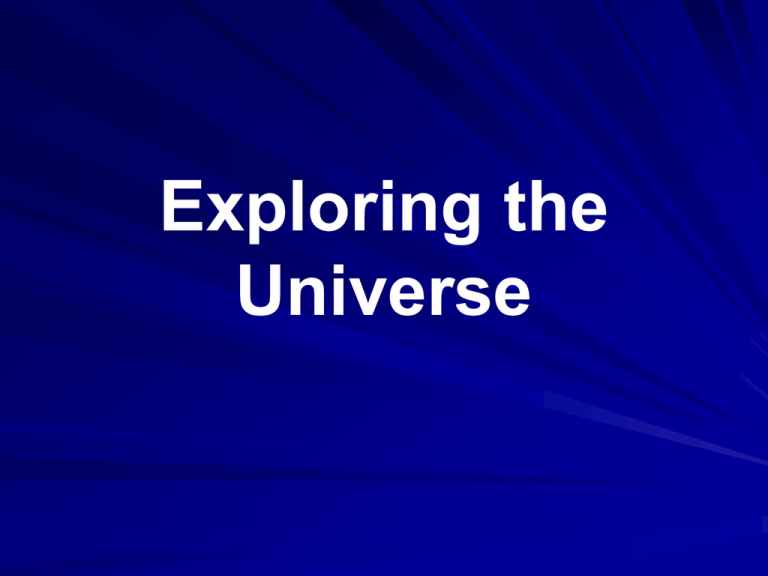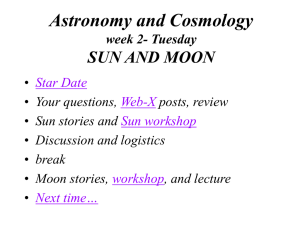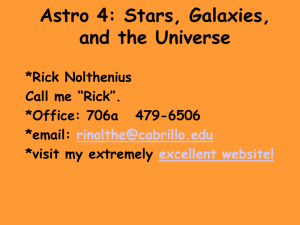Exploring the Universe
advertisement

Exploring the Universe I.) Properties of Stars A. Color and Temperature 1. A star’s color indicates that temperature of its surface a. Hottest stars (surface temps above 30,000K) appear blue b. Milder stars (surface temps between 5,000-6,000K) appear yellow c. Relatively cool stars (surface temps ~3,000K) appear red B. Hertzsprung-Russell Diagram: a graph of the surface temperature (or color) and absolute brightness of a sample of stars 1. H-R diagrams are used to estimate the sizes of stars and their distances, and to infer how stars change over time a. Horizontal axis=surface temperature b. Vertical axis=absolute brightness H-R Diagram 2. Main-Sequence Stars a. Main sequence: A line or sequence in an H-R diagram where most stars spend 90% of their life. i. A diagonal band running from the bright, hot stars on the upper left to the dim, cool stars on the lower right ii. Example: The Sun lies in the main sequence 3. Giants and Dwarfs a. Very bright stars in upper right of H-R diagram are known as supergiants i. Very large (100 to 1000 times the diameter of the sun) b. Just below the supergiants are the giants c. Below the main sequence are the white dwarfs, which are the small, dense remains of a low- or mediummass star D. Energy From Stars 1. Energy moves through the layers of a star by combination of convection, conduction, and radiation a. Convection: rising hot gas moves upward, away from the star’s center, and cooler, denser gas sinks toward the center Brightness of a Star The actual “brightness” of a star depends upon 3 things: actual size of the star, temperature, and distance from Earth c. Radiation occurs when energy radiates out from the star in the form of light i. Travels at the speed of light ii. Light from Sun takes 8 minutes to reach Earth iii. Light and heat both travel this way from a star II.) Life Cycle of Stars A. How Stars Form 1. Nebula: a large cloud of dust & gas in interstellar space a. Composed of mainly hydrogen gas b. Gravity pulls the small pieces of dust to clump together & form a protostar 2. Nuclear fusion begins to take control over the gravity and the star begins to stabilize a. Fusion reactions in the core produce an outward force that balances the inward force of gravity B. Adult Stars 1. Most stars spend 90% of their life in main sequence 2. Once achieving nuclear fusion, stars radiate energy into space C. The Death of a Star 1. When the hydrogen fuel has run out & fusion can no longer continue, the star collapses because the forces are no longer balanced 2. Core collapses because of its own gravity & then rebounds with a shock wave that violently blows the star’s outer layers away from the core The path a star takes in its life cycle depends on its size/mass 3. LARGE MASS STARS : Results in huge, bright explosion called a supernova a. Supernova produce heavier elements up to the element iron. The path a star takes in its life cycle depends on its size/mass http://www.youtube.com/watch?v=xsfie0Ly 0Ic&NR=1&feature=fvwp III.) Expanding Universe A. Hubble’s Law 1. Edwin Hubble used observations of spectral lines from other galaxies to conclude that the universe is expanding a. Lines shifted toward the red end of the visible light spectrum b. http://www.youtube.com/watch?v=FhfnqboacV0 c. http://www.youtube.com/watch?v=3k w4id0NvJ0&NR=1&feature=fvwp 2. Red shift: the apparent shift toward longer wavelengths of light caused when a luminous object moves away from the observer a. Red shift showed that nearly all galaxies are getting farther away from Earth 3. Blue shift: an apparent shift toward shorter wavelengths of light caused when a luminous object moves towards the observer B. Big Bang Theory 1. The Big Bang Theory states that all matter and energy in the universe was compressed into an extremely small volume that 10 to 20 billion years ago exploded and began expanding in all directions What force is responsible for causing interstellar material to condense and form our sun? GRAVITY 3. Evidence for the Bang a. Red shift, and cosmic background radiation b. Cosmic background radiation: steady, but very dim signals in the form of microwaves that are emitted all over the sky i. Scientists believe that these microwaves are the remains of the radiation produced during the Big Bang 4. What is the future of our universe? a. It all depends on the mass of our universe b. One of 3 things can happen: i. Universe can continue to expand ii. Universe can stop expanding and remain constant iii. Universe can collapse in on itself (“Big Crunch”) What causes the moon to “shine?” It’s actually a reflection of the sun’s light off the surface, back to the earth. IV.) Phases of the Moon & Eclipses A. The different shapes of the moon visible from Earth are called phases 1. Moon’s phases are caused by changes in the relative positions of the moon and Earth as the moon revolves around the Earth [Fig 8, p.634] 2. http://aspire.cosmicray.org/labs/moon/lunar_phase3.swf http://www.sumanasinc.com/webcontent/animations/content/moonphase.html B. Eclipse: an event in which the shadow of one celestial body falls on another [Fig 9, p.635] 1. Caused by the changes in relative positions of the moon, sun, and Earth—when all three are lined up in a certain order 2. Solar Eclipse: Moon blocks the sun 3. Lunar Eclipse: Earth’s shadow blocks the moon Solar vs Lunar Eclipses http://www.youtube.com/watch?v=XMyqPx Fh5Zw http://www.youtube.com/watch?v=nXseT WTZlks&feature=related http://www.youtube.com/watch?v=wHxcW SiD_4E C. Tides 1. Caused by the differences in the pull of the moon’s gravity on different areas of the Earth 2. Coastal areas have two high tides and two low tides each day a. Times of the tides will vary because the moon is orbiting around the Earth The Milky Way- our galaxy is a spiral galaxy







